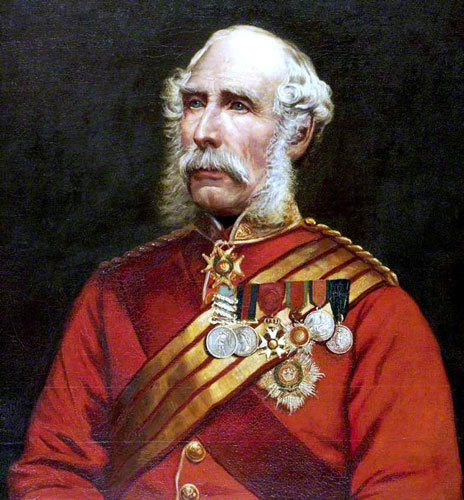Lieutenant-General Duncan Cameron
|
Duncan Cameron was commissioned ensign in the 42nd Regiment (the Black Watch) on 8 April 1825 and was made lieutenant on 15 August 1826, captain on 21 June 1833, and major on 23 August 1839. He became lieutenant colonel on 5 September 1843, while commanding a battalion of his regiment on Malta. Cameron made his name during the 1850s. In the Crimean War he briefly led his battalion before being made commander of the Highland Brigade, in succession to General Colin Campbell. Cameron led the brigade with distinction at the battles of Alma and Balaclava and at the siege of Sebastopol. In the assault on the Redan on 18 June 1855 he found Frants Todleben's military engineering almost as much of a problem as he was later to find Rewi Maniapoto's. Cameron received honours for his Crimean services, including promotion to (local) major general on 9 November 1855, a CB, and Turkish, French, and Sardinian decorations. In 1861 he was sent by the British War Office to New Zealand to replace Major General T. S. Pratt after the First Taranaki War just when Governor Thomas Gore Browne was planning an invasion of Waikato to crush the Maori King movement but Browne was replaced by Governor George Grey and, to Cameron's disappointment, the invasion was initially cancelled. Cameron tendered his resignation in early 1862 but it was declined and Grey told Cameron that the invasion had only been postponed. The two men never really got on well after that. In July 1863, the delayed invasion of Waikato finally got under way and Cameron set out to destroy Maori independence of British rule. He advanced steadily into Waikato and tried to use superiority in numbers and weaponry to force the Maori into a decisive battle which would end the war quickly. Waikato Maori, under Rewi Maniapoto and Tawhana Tikaokao, opposed him with a defensive line centred on Meremere. They also used the strategy of raids on the British lines of communication but were against a far superior army in numbers and equipment and avoided ahead on confrontation by falling back to new defensive positions until Rangiriri on 20 November. Eight British assaults were beaten off but neither side successful until Cameron took the pa and 180 prisoners by unscrupulously manipulating a flag of truce. For this victory he received the KCB on 20 February 1864. Cameron continued his advance until confronted by the huge defensive system at Paterangi the most formidable pa ever built, protecting the their rich agricultural lands to the south. It was manned by their strongest army. Thjios was to be the decisive Maori stand but Cameron simply went around it and attacked the village of Rangiaowhia, where Maori women and children had been sent for safety but most of the Waikato fighters escaped and Cameron was again denied a clear-cut victory he so desired. Then Cameron halted his operations in Waikato basin and took his army to attack a large pa at Pukehinahina which became known as Gate Pa. Here Cameron assembled his best troops and a massive artillery barrage against it. In spite of careful preparations for the battle on April 29 his assault force was led into a trap and decimated. Itb was one of the few times Cameron was seen to lose his temper. This humiliating defeat was avenged to months later Te Ranga on when Cameron’s forces destroyed a partially built pa but Cameron finally realised that frontal assaults against Maori trench and bunker systems were futile. This meant that a decisive victory was impossible. Cameron then turned to Taranaki in early 1865 where conflict had broken out again but he had lost his earlier energy and drive for the campaign as he had become disillusioned with a dishonest war that he suspected was being fought to gain access to Maori land rather than to subdue so called rebels. It was here that he allegedly earned the Maori name The Lame Seagull for being too slow and timid but he being cautious to avoid unnecessary mortality on both sides. He won battles at Nukumaru and Te Ngaio but refused to attack the modern pa of Weraroa as it was too well defended and the losses would have been too high. When the pa had all but been abandoned Governor Grey led his own force and took overran the lightly defended position. Cameron had sent in his resignation shortly afterwards This time it was accepted, and he left the country on 1 August. He died at Cambridge House, Kidbrook, Kent, on 8 June 1888. |
| < Back to Key Characters |
| Reproduced by kind permission of Tom O’Connor as published in the Waikato Times 13 July 2013 |

 Duncan Alexander Cameron was born on 19 December 1808, the son of Sir John and Lady Cameron. His mother's birth name was Brock. Duncan Cameron's forebears, descended from the chiefs of their clan and after thye defeat of the Scots by the English in 1745 pursued careers in the English army.
Duncan Alexander Cameron was born on 19 December 1808, the son of Sir John and Lady Cameron. His mother's birth name was Brock. Duncan Cameron's forebears, descended from the chiefs of their clan and after thye defeat of the Scots by the English in 1745 pursued careers in the English army.